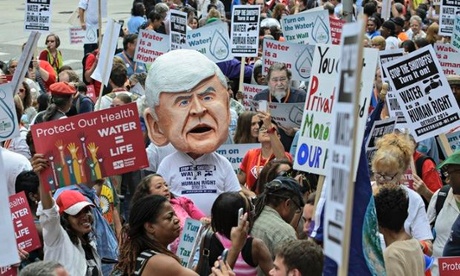Since its March 2013 bankruptcy, the city of Detroit has been beleaguered with considerable economic woes. With $12.3 billion in unpaid liabilities and a purported total debt of up to $20 billion as estimated by the Citizen’s Research Council of Michigan, Detroit would have to undergo a complete restructuring in order to stop the hemorrhage of state dollars. In the midst of this crisis, the municipal government under the direction of Kevyn Orr, Detroit’s emergency manager, has moved to collect on debt owed to the city. More specifically, the Detroit municipal government under the management of Mike Duggan, Detroit’s Mayor, has attempted to straighten out the finances of the chronically ailing water department. Up to 45% of Detroit 173,000 water accounts are late for payment and contribute around $89 million to the municipal government’s debt. So, in order to collect on unpaid water bills in the midst of this crisis, the water department has decided to shut off water supplies to those customers 60 days behind on bills or owing more than $150. Since June, 2013, more than 19,000 residents have had their water shut off, according to the Associated Press.

This situation has become a balancing act between supporting the municipal government’s ability to function effectively in remedying and restructuring the economic framework while making sure that the human rights of Detroit residents are maintained. According to the financial statement made in the current bankruptcy trial, Detroit proposed to eliminate $7 billion from the municipal debt while cutting $1.7 billion from future expenses.
Currently, the water department is working to create payment plans with residents who are unable to pay their debt at a standard rate due to financial problems. Although the policies of water stoppage are draconian, it is hard to argue against their effectiveness. According to the Detroit Sewage and Water Department, the city was able to recover $800,000 in June 2014 compared to about $150,000 in June 2013. Still, most people, including Haas Fellow of Communications Rasheed Shabazz, argue that water shut-offs cause more problems than the meager monetary supplies they reel in– exacerbating everything from public health problems to the social injustices clearly seen in modern Detroit. Although the government has been able to create payment plans with 25,000 customers, a large proportion of the population has yet to reconcile their debt and thus remain cut-off from water. So the situation rests at a standstill. Mary Grant, from the Office of Food and Water Watch, mentioned that the payment plans “might not be enough for every household, for people living in poverty.” This statement remains a stark reality, as many residents cannot afford to take on their debts. In any case, as UN special rapporteur Catarina de Alburqueque stated, “when there is a genuine inability to pay, human rights simply forbids disconnections.” However, during an e-discussion with the Rural Water Supply Network Equity and Inclusion Group she also stated that it remains a common misconception that water should be free. Even amongst those champions of human rights there seems to be an understanding that infrastructure and water management systems need to be funded by the public.
Professor Charlotte Smith of the UC Berkeley School of Public Health suggested that the Detroit municipal government could potentially discern between persons who were unwilling to pay and those unable to pay through public documents like welfare lists and subsidiary listings. These documents could provide insight into which people are under serious financial burden. This action would give the government more information to determine whether they should turn off the water flow to a certain residence. Professor Smith also discussed the major problem with commercial and municipal account water debt and how customer accounts can be distinguished between residents and corporations. This could help determine the intensity with which the municipal government pursues the settlement of certain water accounts especially when non-residential accounts make up more than half of the debt owed to DWSD.
As of now, the plan seems to be the renovation of the Detroit water department by integrating it with the greater Detroit County area to form the “Great Lakes Water Authority.” By incorporating the suburbs into the newly formed water department, the Great Lakes Water Authority would be able to pool together the resources generated from the suburbs to buoy the cresting tide of debt while addressing the problems associated with Detroit’s inadequately maintained 70 year-old water pipes. This increase in customer base could potentially generate the revenue needed to properly stratify utilities costs among customers. This stratification of prices would assure that people of different income brackets are not overwhelmed by the cost of utilities. Professor Smith also discussed how in past situations the consolidation of local water agencies into a regional authority aided in the financial restructuring of the city, like the in the case of the Massachusetts Water Resources Authority or MWRA. The city must still be wary of the potential ability for these new districts to wrest control of the water policies of the newly formed “Great Lakes Water Authority.” As Rasheed Shabazz discussed, with the introduction of dollars from outside Detroit City, the power structures determining water utility policy might realign at the expense of the Detroit urbanite. So although these measures of consolidating water utility and enlarging the customer base could solve the financial situation, there remains a concern that the new “Great Lakes Water Authority” may leave the city’s citizens with a slippery grasp on local water policy.
Featured Image Source: theguardian.com/James Fassinger




